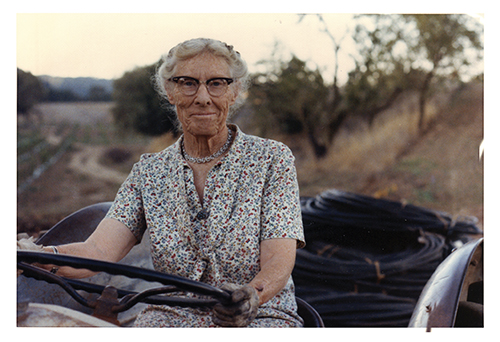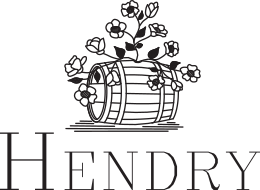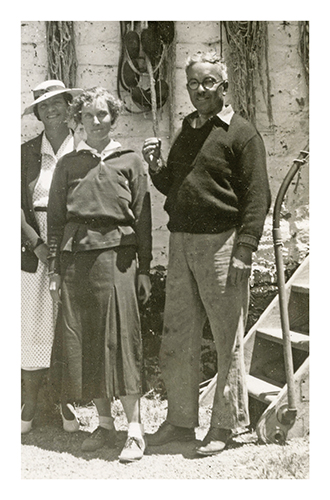History
Hendry Ranch Before 1939
Portions of what is today the Hendry Ranch were among the first vineyards planted in Napa. Pioneering winemakers Frederick and John Sigrist began planting here in 1859, and soon had one of the most extensive vineyards in Napa. By 1880, the ranch was owned by George Barth and John Buhman, and all of the available land was planted to grapevines. For Napa, the planting boom of the late 1800’s was followed by an equally severe bust. In this case it was an insect pest called phylloxera.
Between phylloxera and prohibition - 1888
Phylloxera is a native north American insect that feeds on grapevine roots. North American vines are resistant, but Vitis vinifera, the European vine that produces our wine grapes, is not. Phylloxera was accidentally introduced to Europe, and the subsequent decline of vineyards, and European wine imports, was a factor in Napa’s early success. By planting vinifera on its own roots however, Napa growers inevitably faced the same fate. Sadly, the vineyards of Barth and Buhman, some of the oldest in the valley, were among the first to fail.
The solution to the problem of phylloxera was to graft the vulnerable European plants to North American roots, and by the early 1900’s, the practice was catching on and vineyard acreage was recovering. The next blow to viticulture in Napa was even more serious, however: Prohibition. Prohibition began in 1920, and ended in 1932, but its effects lasted much longer. In 1890, vineyard acreage in Napa surpassed 20,000 acres, and that number was not reached again until 1974.
HENDRY RANCH – 1939
Margaret Munn and George W. Hendry married in 1932. At the time, they lived in Point Richmond, California, and George, an agronomy professor, divided his time between teaching at the University of California campuses of Berkeley and Davis. In 1939, after the birth of their sons George O. and Andrew, George and Margaret purchased the Hendry Ranch, and moved to Napa.
George W. was a teacher, a photographer, historian and adventurer. His professional interests included wheat and other grain crops, root vegetables, and beans. He had a talent for combining his interest in history and travel with his vocation.
In the 1920’s, George traveled around the world documenting and studying agricultural practices in many different countries. Another of one of his hobbies was locating, documenting and researching the buildings associated with the earliest Spanish settlement of California. By studying the composition of the plant material found in the old adobe bricks, he was able to document the earliest varieties of wheat in California, and study the existence and spread of wheat pests.
Wherever he went he carried his camera. Striking black and white images recorded his adventures, travels, and research. Many of them can still be found in the archives of U.C. Berkeley and U.C. Davis.
MARGARET MUNN HENDRY
We are proud of the fact that we have owned and farmed our land for more than 80 years. No one deserves more credit for this accomplishment than Margaret Hendry.
On April 15, 1944, just 5 years after they had purchased the property, her husband George Whiting Hendry died suddenly and unexpectedly from a heart attack. The ranch was left to Margaret, and their two sons George O. and Andrew, who were still young children at the time. For the next 30 years, the resilient and resourceful Margaret single-handedly maintained and managed the ranch, raised her two children, and cared for her ailing father.
During that time, she oversaw the farming of grapes, prune-plums, walnuts and cattle. In addition, she took in boarders at the house, and for a time taught in the local school to make ends meet through tough times. She made certain that both her sons understood the privilege and responsibility of a good education, and that their education included musical training as well. She was able, somehow, to put them both through university. Her eldest, George, graduated from U.C. Berkeley, and her younger son, Andrew, from U.C. Davis.
Napa in the 1940s 50s and 60s
Napa is widely perceived as a well-established grape growing region, but the Napa of these three decades is barely recognizable today. Following prohibition, and as late as 1960, the value of Napa’s prune crop exceeded its grape crop. Grape acreage remained at about half of its 1890 level, and grape prices climbed very slowly from as low as 17 dollars per ton in 1940 to only 120 by 1965. The six acres of vineyard around the house continued to produce grapes, but the rest of the ranch remained as prune orchard and pasture.
George O. Hendry
With his parents and brother, George moved to Napa in 1939 at the age of two. He grew up on the ranch and learned to tend the goats, the cows, the prune orchard and the grapevines. He completed his undergraduate degree at U.C. Berkeley in 1959 and after two years in the navy, completed a masters degree in 1963. Following graduation, George began working for a company called the Cyclotron Corporation. (Cyclotrons are a type of particle accelerator primarily used for the production of radio isotopes used in medical imaging.)
Over the next 40 years, at various companies—including his own—George distinguished himself as a cyclotron designer. Many of his designs and innovations are in use in cyclotrons and hospitals around the world. George’s latest innovative cyclotron design was completed in 2008, and he continues to consult for the company he founded. When he wasn't designing cyclotrons, George was working on the ranch.
Mid-70s Plantings and Changes in Napa
The late 1960s and early 1970s saw a profound change in Napa’s wine industry. The price of grapes was rising rapidly, the focus of wineries was shifting from quantity to quality, and vineyard plantings were on the rise. With his engineering earnings, George built a reservoir, and in 1973, 74, and 75, replanted most of the ranch to vineyard. Some of these plantings returned vineyard to land that had been fallow for nearly 100 years.
Initially, George grafted only Zinfandel and Pinot Noir, but with time, and a growing understanding of the ranch’s potential, George re-grafted 20 acres of the Zinfandel to Chardonnay, and 20 acres to Cabernet Sauvignon.
In the 1970s, Robert Mondavi was a rising star in Napa’s wine industry, and was soon buying the grapes from the ranch. By the late 80s Mondavi was buying all of the Pinot Noir and Chardonnay, and dividing the Cabernet Sauvignon with Opus One. Kent Rosenblum was buying the remaining 9 acres of Zinfandel and bottling a “George Hendry Reserve”. After 50 years of growing, the Hendry Ranch was beginning to develop a reputation for its grapes.
Making Wine - 1992
With the 1970s plantings well established, and the vineyard on firm financial footing, George began to make wine. The first vintage in the Hendry label was in 1992, and included Pinot Noir, Cabernet Sauvignon, and Zinfandel. Over the next ten years, George sold smaller and smaller quantities, and crushed more for his own wines. George’s cyclotron business partner Jeff Miller, and neighbor Susan Ridley became partners in the winery business, and helped with its expansion.
Vineyard Expansion - 1994
Another significant development in the history of the ranch was the expansion of the vineyard through the purchase of a neighboring property in 1994. This property is a continuation of the gently sloping bench lands of the original Hendry Ranch and contains 47 plantable acres. All of these acres however, were grafted to AXR-1 rootstock and were dying from phylloxera, Napa’s second epidemic. AXR replanting began in 1993, and continued until approximately 2001, eventually totaling nearly 70 acres. The removal and redevelopment of these vineyards created new blocks, included new varieties such as Pinot Gris, Merlot, Malbec, Petit Verdot, Primitivo, Cabernet Franc. With this property addition, the Hendry Ranch now totals 114 vineyard acres and is divided into thirty numbered blocks.
Mike Hendry - Vineyard Manager
George’s brother Andrew moved from the ranch after high school, and pursued a career in education. This path eventually led him to Edmonton, Alberta, Canada, and the University of Alberta where he completed his Ph.D. in 1975. Upon the completion of his degree, he accepted a job working for the province of Alberta in the administration of adult vocational schools. Andy and Alice Hendry had two sons, Michael and Andrew.
Each year, the family would spend spring break at the Ranch, and for Michael, these spring trips fostered an interest in viticulture. In 1987, Mike spent the summer in Napa working in the vineyard. After his high school graduation, in 1988, Mike spent the next year working in the vineyard. After completing degrees in Physics and Engineering, Mike began to manage the vineyard full time in January 2001. He and his wife Molly and their son Drew live on the ranch, where young Drew is proving himself to be a quick learner when it comes to tractors and forklifts.
Winery Construction - 2000
The next major step in the evolution of the ranch was the construction of the winery building. By 2000, production of the Hendry label had increased to the point that the construction of a winery on the ranch property made sense, practically and financially. George spent almost 5 years considering various design ideas, and once again, re-invested his cyclotron and vineyard earnings back into the ranch. Groundbreaking for the winery began in the fall of 2000, and the building was ready just in time for the 2001 harvest. The expansion of winery equipment continued for several years, and ended in 2008 with the addition of a bottling line. Now all aspects of the winemaking business are conducted on the ranch property.
EIGHT DECADES OF FAMILY FARMING
At Hendry, we are proud of the fact that we have been continuously farming the ranch for more than eighty years. George, Mike, and our vineyard and winery crew thank you for your support, and we look forward to the interesting and productive decades that lie ahead.




